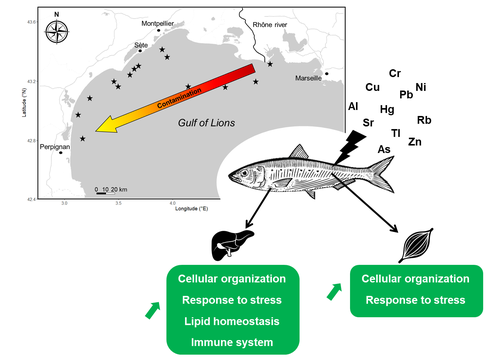
PRUD'HOMME Sophie
- Laboiratoire Interdisciplinaire des Environnements Continentaux, Université de Lorraine, Metz, France
- Aquatic ecotoxicology
Recommendations: 0
Review: 1
Review: 1

Molecular response to multiple trace element contamination of the European sardine
Molecular-level responses highlight physiological stress in muscle and liver tissue of apparently healthy European sardine specimen
Recommended by Davide Anselmo Luigi Vignati and Abdulsamie Hanano based on reviews by Sophie Prud'homme, Roberta Bettinetti and 1 anonymous reviewerFish is an essential component of healthy human diets and the preservation of fish stocks and other marine resources is included as a target of Sustainable Development Goal 14 ‘Conserve and sustainably use the Oceans, Sea and Marine Resources for Sustainable Development’ (UNEP). However, several fish stocks remain in sub-optimal (or worse) conditions due to overfishing and a range of stressors including chemical pollution. Chemical pollution can result in high level of chemicals in fish making it unsuitable for human consumption. Furthermore, the occurrence of chemical-related physiological stress in otherwise apparently healthy fish requires additional research efforts. In natural environments, further complexity arises from fish being simultaneously exposed to multiple contaminants/stressors as opposed to laboratory investigation usually dealing with one or very few contaminants/stressors at a time (Schäfer et al., 2023).
Beauvieux et al. (2024) examined the possible role of accumulation of multiple elements on the physiological status of first-year-of-life specimen of European sardine collected in the Gulf of Lions (northeastern Mediterranean Sea) as a contributing factor to the declining sardine population observed in the region since 2008. The ultimate objective of the paper was to identify potential biomarkers of stress in fish otherwise not exhibiting any anomalies in body condition, in agreement with the principles of chemical stress ecology put forward by van der Brink (2008).
Out of a total of 105 specimen, individuals were selected according to the lowest (n = 14) or highest (n = 15) levels of contamination and subject to proteomic analysis of liver and red muscle tissues. A first Principal component analysis on all specimen highlighted the possible influence of the Rhone river as a source of geogenic and anthropogenic elements to the Gulf of Lions.
A second PCA performed only on specimen selected from proteomics analysis allowed to identify three elemental mixtures possibly responsible for the observed physiological effects. Proteomic analysis in liver and muscle tissue identified both similarities and differences in the pathways involved in response to stress. More in detail, the expression patterns of Myosin and Myomesin were downregulated in red muscle for highly exposed specimen, which suggests possible effects of elemental accumulation on the locomotion abilities of Mediterranean sardines. Pathways involved in lipid metabolism and immune processes were up-regulated in liver, pointing to increased energetic costs for maintaining the overall fish homeostasis in presence of metal contamination. It is interesting to note that these effects were observed at concentrations below the legal thresholds for human consumption (except for As), albeit such thresholds are available only for a limited number of elements (Cd, Pb, Cd, As and inorganic Sn) (EU, 2023).
Although stressors other than trace elements could contribute to the observed molecular responses, as acknowledged by the authors themselves, Beauvieux et al. (2024) show that biological responses at lower levels of biological organization can provide both early-warning indications of potential adverse effects in the long term and better understanding of drivers of population decline. By advancing our knowledge of the physiological responses to trace elements and identifying potential biomarkers, this study lays the groundwork for more effective monitoring and conservation strategies. Further studies addressing the combined effects of multiple environmental stressors remain essential to develop holistic approaches to marine ecosystem management and species conservation.
References
Beauvieux A., Fromentin J.-M., Saraux C., Romero D., Couffin N., Brown A., Metral L., Bertile F., Schull Q. (2024). Molecular response to multiple trace element contamination of the European sardine. bioRxiv, ver. 4 peer-reviewed and recommended by Peer Community in Ecotoxicology and Environmental Chemistry. https://doi.org/10.1101/2024.02.16.580673
EU (2023). Commission Regulation (EU) 2023/915. https://eur-lex.europa.eu/eli/reg/2023/915/oj/eng
Schäfer R. B., Jackson M., Juvigny-Khenafou N., Osakpolor S. E., Posthuma L., Schneeweiss A., Spaak J., & Vinebrooke R. (2023). Chemical Mixtures and Multiple Stressors: Same but Different? Environmental Toxicology and Chemistry, 42(9), 1915-1936, https://doi.org/10.1002/etc.5629
UNEP: https://sdgs.un.org/goals
Van den Brink P. J. (2008). Ecological Risk Assessment: From Book-Keeping to Chemical Stress Ecology. Environmental Science & Technology, 42(24), 8999-9004. https://doi.org/10.1021/es801991c